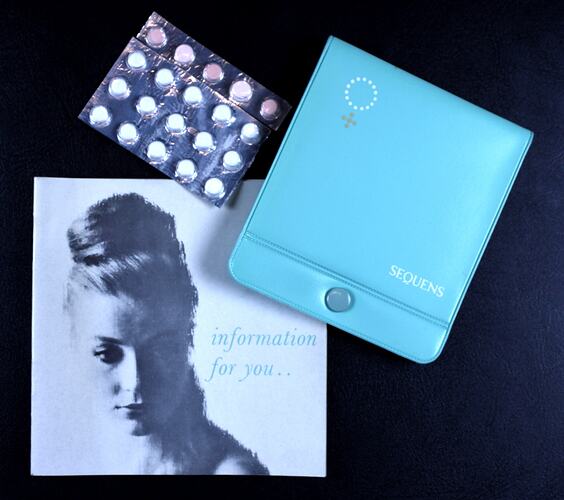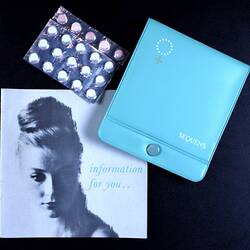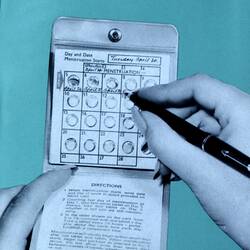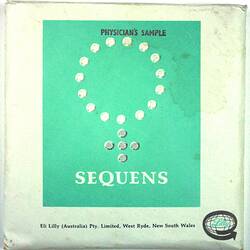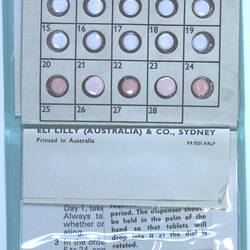Summary
Kit consisting of two vinyl folders, each containing 24 pills and information leaflets, an instruction booklet, and a paper envelope.
This unused kit was issued by Eli Lilly (Australia), the local arm of American drug company Eli Lilly and Company. It is stamped 'Physician's Sample', so was given to a doctor to promote the availability of this kit for female patients.
The 'Pill' was introduced into Australia on 1st February, 1961, and this kit dates to the first few years of its availability.
Physical Description
Contraceptive pill kit, contained in a square cream paper envelope, with product information and a female gender symbol created from pill-shaped dots printed on the front. Inside are two mint coloured vinyl folders, secured with a metal press stud. Each opens to reveal a card calendar containing 15 white pills ( Mestranol 80 mcg) and 5 pink pills (Chlormadinone Acetate 2 mg and Mestranol 80 mcg) in clear blister packs and four information leaflets contained in clear pockets. The kit also contains a booklet consisting of 6 double sided white glossy pages printed with extensive text secured inside a white glossy cover with two metal staples. On the front is printed a black and white photograph of a young woman, with company details printed on outside of the back cover.
Significance
This kit is significant as a rare surviving unused example of an early contraceptive pill instructional kit. It illustrates the way the 'Pill' was marketed to Australian women in the early years after its introduction.
On the 11th May 1960, the world's first oral contraceptive pill was introduced to American women. Nine months later, on the 1st of February 1961, Australia became the first country in the Asia Pacific Region to offer the oral contraceptive pill. Available only by a doctor's prescription, it was initially only available to married women, as it was thought offering it to single women would encourage promiscuity. As the `Swinging Sixties' progressed, it became available to any adult woman who requested it.
The oral contraceptive pill proved very popular, as it gave women control over their fertility, through the option of `planned parenting', and over their bodies in ways not previously available to them. In its original form, the 'Pill' contained enormous quantities of hormones, which resulted in constant nausea and other undesirable side effects. Later research led to a reduction in hormone levels without reducing their reliability.
More Information
-
Collecting Areas
-
Acquisition Information
Purchase
-
Manufacturer
Eli Lilly (Australia) Pty Ltd., 112 Wharf Road, West Ryde, Greater Sydney, New South Wales, Australia, 1961-1965
-
Inscriptions
Printed on front of envelope: 'PHYSICIAN'S SAMPLE/ SEQUENS/ Eli Lilly (Australia) Pty Limited, West Ryde, New South Wales' Printed on front of booklet: 'information/ for you ..' Printed on front of vinyl pill holder: 'SEQUENS'
-
Classification
-
Category
-
Discipline
-
Type of item
-
Overall Dimensions
115 mm (Width), 10 mm (Depth), 115 mm (Height)
Dimension of envelope when holding complete kit.
-
Keywords
